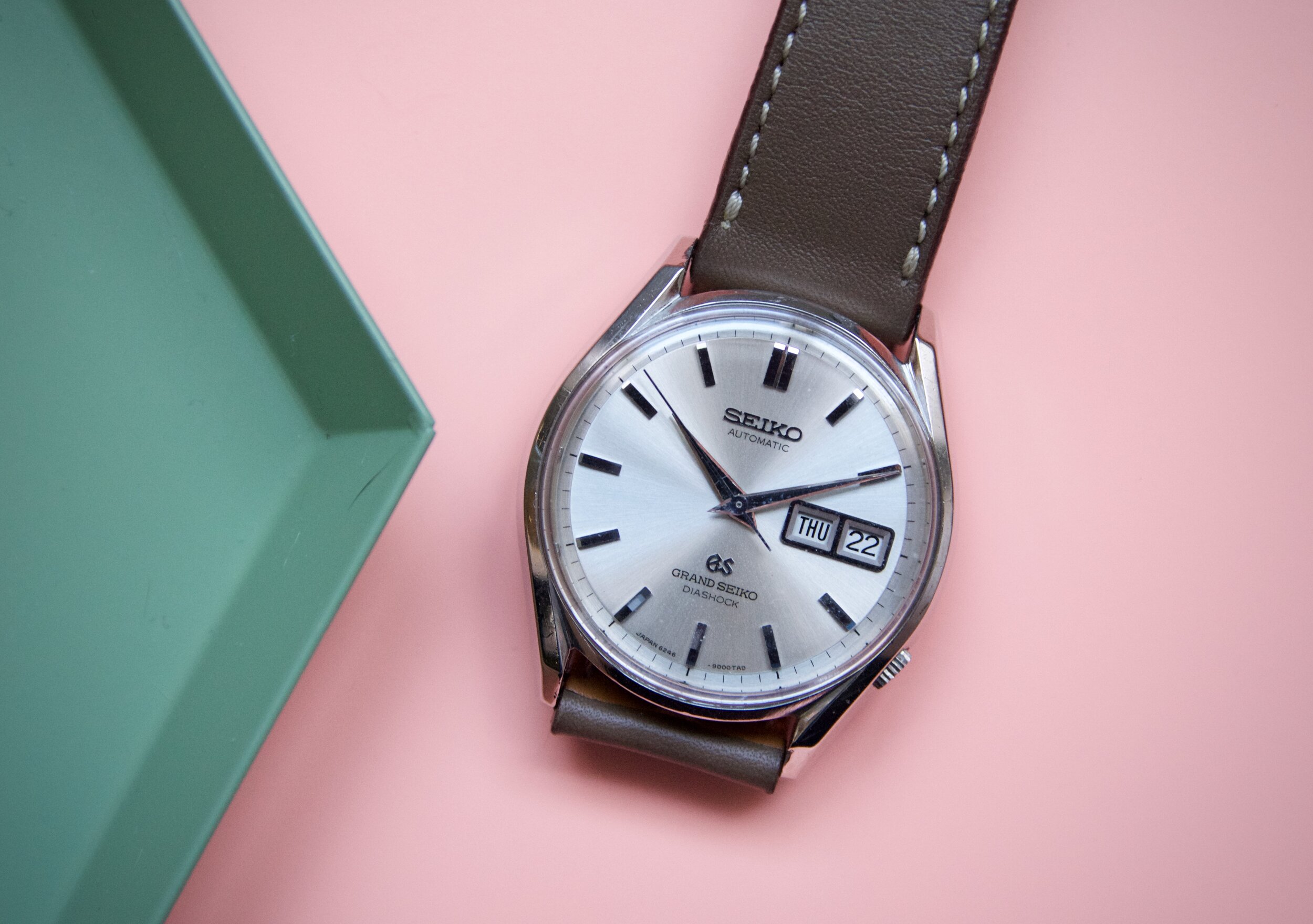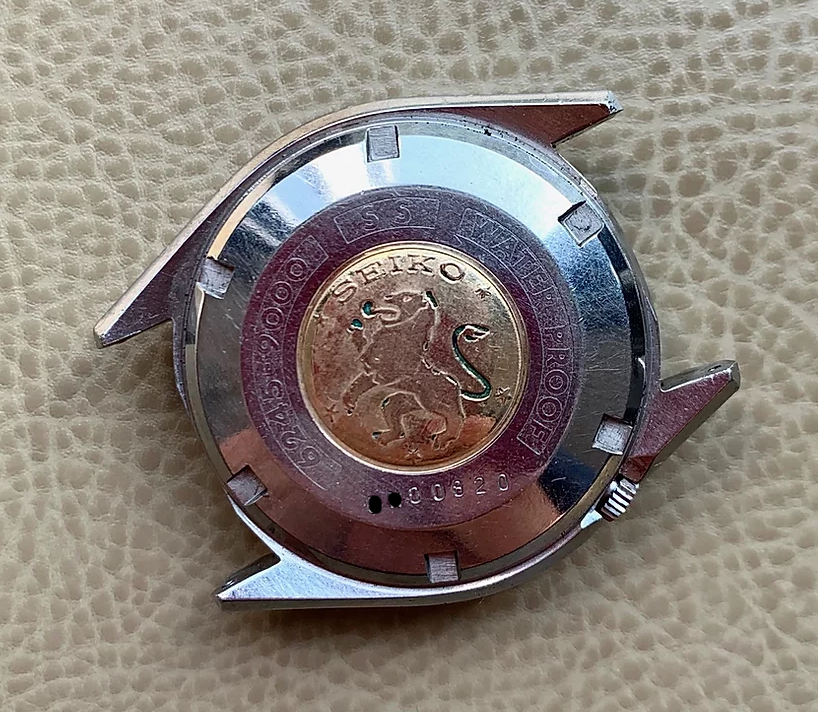Since writing about the “perfect Grand Seiko two-watch collection”, I’ve gotten some questions about the vintage watch featured in that piece, the Grand Seiko 62GS. The Grand Seiko references 6245 and 6246 (or “62GS”) continue to be an excellent entry point into collecting vintage Grand Seiko. Not only historically important, the 62GS just looks good — there’s a reason so much of modern Grand Seiko’s designs reference it. While some of designer Taro Tanaka’s Grammar of Design cases for Grand Seiko get a bit structural, the 62GS is not that. Recently, I saw someone refer to the 62GS as “Tanaka’s take on lyre lugs”, and that nails it (h/t @southslope.nyc). While the Western version of lyre lugs (see, e.g., Universal Geneve Polerouters, later Omega Speedmasters) are much more flowing and romantic, the 62GS’s are more architectural. Some vintage Grand Seikos begin to look a bit like a Cybertruck strapped to the wrist. The 62GS is more like … a Model S? Is that the one I can’t afford?
The 62GS was Grand Seiko’s first model to feature an automatic movement, either the caliber 6245a with date complication or 6246a with day-date complication. As I recently wrote:
The 62 series was not a wholly new caliber, but rather the result of refining Seiko’s automatic calibers dating back to the first Seikomatics featuring Seiko’s “Magic Lever” winding system. The Seikomatic “Chronometer” was available as early as 1965, with both the movement and the case shape bearing a strong resemblance to the forthcoming 62GS.
The 62GS calibers featured 35 (6245) or 39 (6246) jewels, beating at 19,800 bph. Having worn one for awhile now, there’s something about the movement itself that feels substantial in a way other vintage calibers sometimes don’t. You can feel it strongly, defiantly whirring — giving the Swiss a middle finger, but in that subtle, Japanese way — like the faceted, 36mm case just isn’t enough to contain this feat of Japanese engineering.
The 62GS was produced for just a couple years, first hitting the market in 1966 and staying in production through 1967. Two different case backs were used, depending on the year of production: a lion medallion or a Grand Seiko medallion. Combined with the two different movements, this gives a total of four references for the 62GS:
6245-9000: Produced in 1966. 6245a movement, lion medallion case back.
9246-9000: Produced in 1966. 6246a movement, lion medallion case back.
9245-9001: Produced in 1967. 6245a movement, Grand Seiko medallion case back.
6246-9001: Produced in 1967. 6246a movement, Grand Seiko medallion case back.
These reference numbers are engraved into the case backs around the medallion for each model. Note that even on the later 9001 models with Grand Seiko medallion case backs, you’ll find dials printed “624x-9000” at 6 o’clock. This seems completely fine and correct — perhaps Grand Seiko printed more dials than cases and continued using them even after changing the case back reference. All models were available in both gold cap and stainless steel cases, meaning a total of eight different iterations of the 62GS can be found.
Grand Seiko 6245 with lion medallion | Special Dial
Also on the case back you’ll find a serial number engraving which can be deciphered to tell something about the watch. The first digit is the year of production (6 or 7, in the case of the 62GS), the second is the month, and the final four digits are a unique production number. The months are designated 1-9 for January-September, then O, N and D for October, November, and December.
Across references, the dial remains the same: applied “Seiko Automatic” branding at 12 o’clock, with the applied GS logo at 6 o’clock, sitting above the a printed Grand Seiko and Diashock. The branding, with “Seiko” prominently above Grand Seiko, illustrates how Grand Seiko was still an emerging branding concept for the Seiko company, as much an indication of its technical accuracy as an actual consumer brand. The Swiss had gotten pissed at Seiko for using the word “Chronometer” in its branding a few years prior, so Seiko went ahead and called itself Grand Seiko instead, developing an internal “Grand Seiko” accuracy standard that was more rigorous than the Swiss’ “superlative” standard.
Collecting the 62GS
As with any vintage watch, be on the lookout for over-polished cases. Because of the 62GS’s faceted case and sharp angles, cases tend to look pretty soft and lose much of their Tanaka charm after just a polish or two. Look at the faceted lugs for sharp angles. The 62GS also had a bezel-less construction which meant a special box-shaped crystal was fused directly to the case. Look for a correct crystal with sharp walls that almost form a right angle into the case.
Because the 62GS is similar in form and function to the Seikomatic “Chronometer” that was produced until at least 1965, there seem to be stories of collectors acquiring a “62GS” that’s actually a Grand Seiko dial swapped into an older Seikomatic Chronometer case. Check the serial number on the watch’s case back to make sure its production date is around 1966-67, the short time frame that seems to be correct for a 62GS.
Obviously, examples are most readily available in Japan. To get familiar with Japanese vintage dealers, follow some of the popular Japanese-language vintage watch hashtags (here and here, h/t Agaki). However, Western dealers are catching on. As of this article, a sharp, clean 62GS can still be had for a couple thousand dollars. You’ll pay a premium to buy from a Western dealer, and that’s fair enough for the convenience of not having to deal with customs (but it shouldn’t be a 2x premium).
Cap gold examples are more rare than the stainless steel version, and even more rare to find in collectible condition. But honestly, is anyone buying cap gold watches right now?
Concluding Thoughts
Listen, I know some people don’t “get” vintage Grand Seiko. The design language is different from what the Swiss were doing at the time. But it also feels like more often than not, the Japanese are simply ahead of the West when it comes to appreciating design, craftsmanship and engineering. If there’s one accessible entry point into understanding what vintage Grand Seiko is all about, to me, the 62GS is it.



